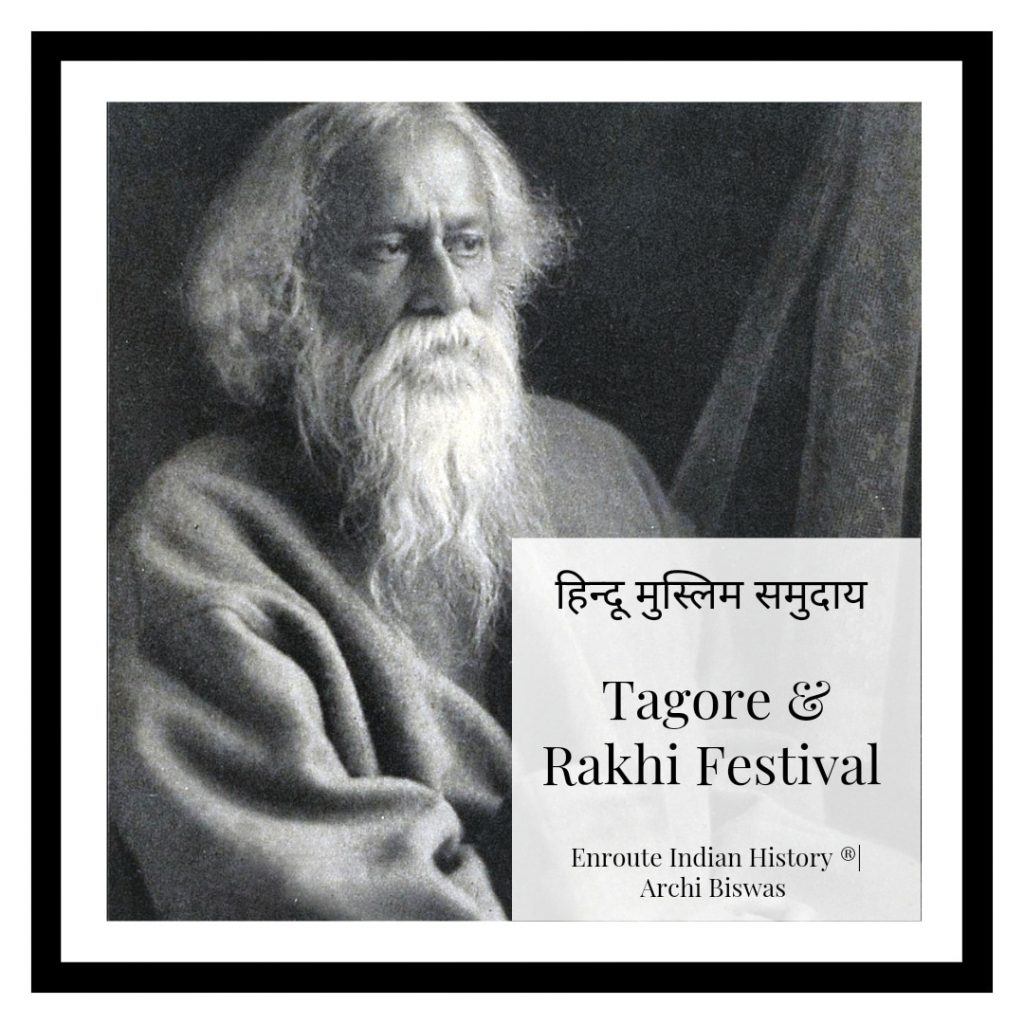
Article Written By EIH Researcher And Writer
Archi Biswas
The origins of Raksha Bandhan can be traced back 6000 years. From Draupadi and Lord Krishna to Rani Karnavati and Emperor Humayun, the legacy of Raksha Bandhan is quite diverse. Raksha Bandhan traditionally marks the bond between brothers and sisters. Rabindranath Tagore used the holy thread of the Rakhi to unite two regions that had been partitioned by the then Imperial British authority about 115 years ago.
The British administration, which intended to partition India’s eastern region into Bengal and Bangladesh, terrorized India in 1905. Even though British authoritarians described it as an administrative measure intended to benefit the public, the Bengali people understood that it was designed to plan, divide, and alter the course of the expanding Bengali population. They tried to separate Muslims from Hindus; thus, there was also a tinge of religion in it. The British government approved the partition orders in August 1905 and went into force on October 16 of that same year. However, the date fell during the Hindu community’s celebration of Raksha Bandhan in the month of Shravan. By depicting an image of harmony between the two groups, Tagore skilfully exploited the ideas of brotherhood, togetherness, and “the thread of protection” to protest against the British government’s partition policy.
Tagore designated October 16, the day of the partition, as a national day of mourning, during which Bengali households did not prepare food. On October 16, Tagore swam in the Ganga to start his day. He proceeded around the streets, tying rakhis on the wrists of everyone he encountered while accompanied by a procession from the banks. The enthusiastic poet had an extensive collection of rakhis, but those with him thought he had gone too far when he wanted to enter the mosque south of his home and tie the maulvis’ wrists with rakhis. People were crowded along both sides of the street. Tagore had written a hymn, especially for the occasion, a supplication to God to keep Bengal safe and united, which was being sung by those who were accompanying him. Women blasted conch shells and sprinkled puffed rice at the procession from the roofs. Here, the National Fund was announced, and donations from the public were requested. The fund would provide scholarships to eligible students and pay for training Bengali businesspeople in science and technology in England.
A majestic structure representing the union of the two Bengals, Federation Hall, had its foundation stone set that afternoon. Barrister Ananda Mohan Bose presided over the meeting, but because of his age and health, Tagore read the speech instead. From Federation Hall to the majestic Basu Bati, the Pasupati and Nandalal Basu residence in Bagbazar, the second procession of the day started from there.
When the British government was trying to divide Bengal and break the Hindu-Muslim unity, Tagore appeared as a hope for peace. His deed served as a rallying cry for all communities to unite and defend one another. By tying rakhis on each other’s hands and promising to protect one another from the fear of the previous government and separation, he transformed Raksha Bandhan into a movement that united Hindus and Muslims.
When Bengal was violently partitioned in 1947, Tagore’s dream of an undivided India was quickly dashed. Thousands of individuals were forced to flee their homes, loved ones, and country. Refugees left their homes and entered Bangladesh and India at their respective borders.

Rabindranath Tagore’s Hindu -Muslim unity Raksha Bandhan initiative in progress in Calcutta, 1909
Source: https://openthemagazine.com/cover-stories/an-east-bengal-in-west-bengal/
BIBLIOGRAPHY
1. Desk, DH Web. “Tagore’s Message of Communal Harmony with a Rakhi.” Deccan Herald. DH News Service, August 22, 2021. https://www.deccanherald.com/national/tagores-message-of-communal-harmony-with-a-rakhi-1022300.html.
2. Ghosh, Deepanjan. “In Bengal, the Bond of Rakhi Once Symbolised Eternal Protection – between Hindus and Muslims.” Scroll.in. Scroll.in, August 8, 2017. https://scroll.in/magazine/846275/in-bengal-the-bond-of-rakhi-once-symbolised-eternal-protection-between-hindus-and-muslims .
3. Desk, India Today Web. “This Is How Tagore Turned Rakshabandhan into a Symbol of Unity between Hindus and Muslims.” India Today, August 14, 2019. https://www.indiatoday.in/education-today/gk-current-affairs/story/this-is-how-tagore-turned-rakshabandhan-into-a-symbol-of-unity-between-hindus-and-muslims-1580872-2019-08-14 .
4. Staff, News9. “Raksha Bandhan 2022: When Rabindranath Tagore Used Rakhi to Protest against Partition of Bengal and British Raj.” NEWS9LIVE. News9live, August 10, 2022. https://www.news9live.com/knowledge/raksha-bandhan-2022-when-rabindranath-tagore-used-rakhi-to-protest-against-partition-of-bengal-and-british-raj-188446 .
5. “’Rakhi’- Thebond Used by Rabindranath Tagore to Bridge Communal Divide.” Get Bengal. Accessed August 10, 2022. https://www.getbengal.com/details/rakhi-thebond-used-by-rabindranath-tagore-to-bridge-communal-divide .
6. Majumdar, Mayukh. “How Rabindranath Tagore Used Rakhis to Bring Hindus and Muslims Together.” Man’s World India, August 1, 2019. https://www.mansworldindia.com/culture/features/how-rabindranath-tagore-used-rakhis-to-bring-hindus-and-muslims-together/ .



















